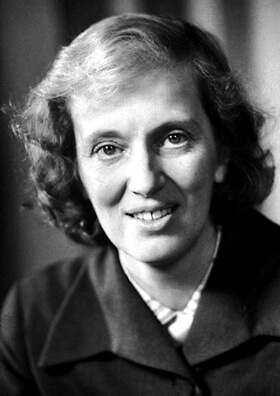Kropot-Hodgkin deciphered, among other things, the structure of the molecules cholesterol, penicillin, vitamin B12, insulin, lactoglobulin, ferritin and the tobacco mosaic virus.

Today marks the 104th birthday of Dorothy Crowfoot Hodgkin (in English: Dorothy Crowfoot Hodgkin; May 12, 1910 - July 29, 1994), a British chemist who won the Nobel Prize in Chemistry in 1964 for her pioneering research in X-ray crystallography, which is used to decipher the structure The spatial of biological molecules.
Many years before Prof. Ada Yonat deciphered the structure of the ribosome, it was Hodgkin who used crystallographic techniques successfully for years, deciphering, among other things, the structure of the molecules cholesterol (1937), penicillin (1945), vitamin B12 (1954), Insulin (1969), lactoglobulin, ferritin and the tobacco mosaic virus.
Dorothy Kropot was born in Cairo on May 12, 1910 where her father served in the Egyptian Education Service. Later the family moved to Sudan, where he became the director of education and antiquities. As a child, Dorothy visited Sudan and was greatly influenced by the country.
After retiring from his post in Sudan in 1926, her father devoted his life to archaeology, and worked for several years as the director of the British School of Archeology in Jerusalem, where he excavated Mount Opal, Jerash, and a city in Samaria. Her mother, Grace Marie Croft (Hood) assisted her husband in his work, and became an authority in her own right regarding wave theory in her early days. She was also a botanist and spent her free time illustrating plants in Sudan and Israel.
Her parents were in Israel for about 20 years (until the end of World War II), but they sent Dorothy and her sister to Britain. Dorothy spent one excavation season between school and university with her parents when they excavated in Jerash in Jordan where she painted mosaics, she enjoyed the experience until she asked to give up chemistry in favor of archaeology.
She became interested in chemistry and crystals at the age of 10, who encouraged this was Dr. AP Joseph, a friend of her parents in Sudan, who taught her chemistry and helped her stay there to analyze the composition of ilmenite mineral found in basic rocks and which contains iron in small amounts. Most of her childhood was spent with her sister at her aunt's house in Gladstone, Norfolk, UK, where she attended Sir John Lehmann's school in 1921-28. Another girl, Nora Posey and Dorothy Croft were allowed to join the boys during chemistry lessons at school, with teacher Dilly. At the end of her studies at school she decided to study chemistry, and maybe even biochemistry at university.
She studied at Oxford and Summerville College between 1928-1932 and became a doctoral student of Margery Frey, then the principal of the college. For a short period in the first year, she combined archeology and chemistry, where she examined glass objects from Jerash together with A.G. Harley took a specialized course in crystallography, and following the advice she received from one of the teachers, P. Brewer, who became her mentor, she began conducting research in X-ray crystallography. Later, she was a research student of H.M. Powell in the first study of the behavior of the element thallium, after a summer visit to Prof. Victor Goldschmidt in Heidelberg.
A chance meeting on the train between Dr. AP Joseph and Prof. Lowry brought Dorothy to Cambridge to work with Prof. John Desmond Burnell. There she helped him in researching crystallography of crystals, until in 1932 he decided to turn to another field and left her to handle the field. She returned to Oxford and Summerville in 1934 and remained there, except for short spells, mainly to teach chemistry at a women's college.
Upon her return to Oxford, she began raising funds to build an X-ray machine with the help of Sir Robert Robinson. She later received assistance from the Rockefeller and Nuffield foundations. She continued the research she had begun at Cambridge with Prof Burnell on sterols and other interesting biological molecules, including insulin, initially with only a research student or two. The department was spread over several rooms in the university museum. Research on penicillin began in 1942, during World War II, and on vitamin B in 1948. Her research group gradually grew and attracted students and researchers from prestigious universities who worked specifically on X-ray analysis of natural products.
In 1946 she participated in the meeting that led to the founding of the World Crystallographic Union and visited several countries for scientific purposes including China, the USA and the Soviet Union. She was elected a Fellow of the Royal Society in 1947, a Foreign Member of the Royal Netherlands Academy of Sciences in 1956 and of the American Academy of Arts and Sciences in 1958.
In 1964, she was awarded the Nobel Prize in Chemistry for her discoveries in the field of crystallography that helped decipher the spatial image of important biological molecules and thus advanced the medicine of diseases related to them.
In 1937 Croft married Thomas Hodgkin, son of the historian and grandson of two others, whose field of expertise was the history and politics of Africa and the Arab world, and who served as director of the Institute of African Studies at the University of Ghana. The two have three children and three grandchildren. Their eldest son is a mathematician, almost all of them chose a career that brought them to Africa.
